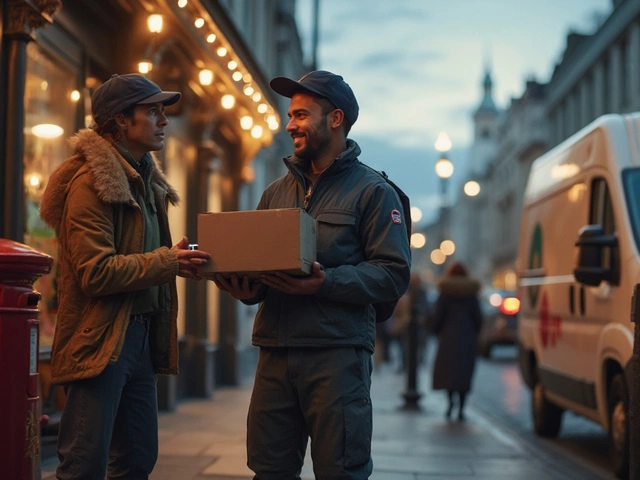If you’ve ever sent or expected a package, you’ve probably asked yourself, “How long does a courier take to deliver?” This isn’t a one-size-fits-all answer—there are a bunch of moving parts involved before that box lands on your doorstep. Some couriers can deliver across town in hours, while others might take days, especially if your parcel is crossing borders.
Here’s something that’s easy to miss: the speed is rarely just about the courier’s van or bike. What matters is the type of service you choose, where the package is going, and honestly, even things like time of day or a game of chance with traffic and weather. There’s way more to it than just “pick up and go.”
Cost often goes hand-in-hand with speed. Express delivery and same-day services work fast, but standard deliveries save money if you’re not in a rush. Before you pick a service, think about how urgent the item is and whether the sender and recipient locations are close together or in different countries.
- What Really Affects Delivery Time?
- Standard, Express, and Same-Day Couriers: What’s the Difference?
- International vs. Domestic Deliveries
- Why Your Package Might Be Delayed
- Tips to Get Your Courier Delivery Faster
What Really Affects Delivery Time?
When you’re tracking a package, the question that matters most is: how soon will it actually show up? Several concrete things influence the answer. It’s not just about how far the van has to drive—there’s a bit more behind every delivery timeline.
Service level makes a huge difference. Choosing between standard, express, and same-day options can cut your wait from several days to just a few hours. For example, FedEx SameDay delivers within city limits in under 2 hours, while standard ground services can take up to five business days coast-to-coast in the US.
- Courier delivery time jumps up fast when you cross borders—customs checks, import paperwork, and varying national holidays can all add hours, or even days.
- Distance is still a basic factor. A package sent across town can sometimes arrive the same day. If it’s going across the country or internationally, think days instead of hours.
- Pickup cut-off time also matters. Couriers usually have an end-of-day deadline; packages sent after that time only start moving the next day.
- Traffic and weather are classic culprits behind delays. Extreme weather events, major city gridlocks, or even local roadworks can slow things down and throw delivery times off.
- Volume surges—think Christmas, Black Friday, or new iPhone launch weeks—stretch delivery networks. During peak periods, even "guaranteed" services may take longer due to backlog.
Here’s a real-world look at average delivery estimates from popular US couriers. These are typical business days, not counting rare disruptions:
| Service | Delivery Time |
|---|---|
| UPS Ground | 1-5 days (US) |
| FedEx Express Saver | 3 days (US) |
| USPS Priority Mail | 1-3 days (US) |
| International Express (DHL) | 2-5 days (Worldwide) |
| Same-Day Local (various) | Under 24 hours, often 2-4 hours |
Always double-check delivery windows before you book—those little details like time of day, local holidays, and any required signatures have a sneaky way of stretching out your wait.
Standard, Express, and Same-Day Couriers: What’s the Difference?
Choosing the right courier option isn’t just about price—it decides how long you’ll wait. Most people are surprised by how much these services actually vary, both in speed and in cost. You’ll see “standard,” “express,” and “same-day” everywhere, but what does each really mean?
Courier delivery time will depend a lot on which of these services you pick:
- Standard couriers usually deliver within 1 to 5 business days, depending on the distance. Think of standard shipping for stuff that isn’t urgent—like books or non-perishables. It’s the cheaper choice and used for most domestic deliveries.
- Express couriers mean speed. You’ll get your package by the next business day or sometimes in two days max. This is the choice for people who don’t want to wait but don’t need it right now.
- Same-day couriers are exactly what you think. Your package arrives the very day you send it—great for emergencies like forgotten documents or urgent gifts. But it comes at a premium price tag and works best in big cities.
Here’s a quick comparison of the timelines and prices most people can expect:
| Service Level | Typical Delivery Time | Useful For | Average Cost (Within City)* |
|---|---|---|---|
| Standard Courier | 1-5 business days | Non-urgent parcels | $8 - $20 |
| Express Courier | 1-2 business days | Important docs, small parcels | $20 - $40 |
| Same-Day Courier | Few hours, same day | Critical, time-sensitive deliveries | $35 - $70 |
*Prices can vary by location and provider; these are rough 2025 averages for major US cities.
The big names like FedEx, UPS, and DHL all offer their own versions of these services. As a spokesperson from FedEx summed up recently,
“Same-day and express deliveries keep growing because people value speed—even if it costs more. But standard shipping is still the go-to for everyday parcels.”
So when you’re picking a shipping option, think about how much waiting you can handle, and whether speed or savings matter more for this particular package.

International vs. Domestic Deliveries
Not all courier deliveries work the same way, and the biggest difference is whether your package is staying inside the country or crossing borders. Domestic shipments, like sending a box from Miami to Chicago, usually get delivered within 1-5 business days depending on the speed you choose. For same-city deliveries, it can be as fast as a few hours. Couriers use direct ground transport and don’t have to deal with customs, which really keeps things simple.
Now, sending something overseas is a whole different ballgame. International courier services can take anywhere from 2 days (for premium express shipments) to 2 weeks with standard options. Customs checks, security screenings, and distance all add time. Major companies like DHL, FedEx, and UPS consider three to five business days as the standard minimum for popular global routes, but rural or high-security areas might require more.
According to UPS: "International shipping time depends on destination country, customs procedures, and the specific service level. Fastest available options deliver in as little as 1-3 business days to major cities worldwide."
There are a few things that often cause international deliveries to take longer:
- Customs clearance – Every package entering a new country has to go through this, and it’s unpredictable.
- Correct paperwork – Mistakes here mean delays or even returns, so double check customs forms and declarations.
- Different shipping networks – Couriers handing over packages to third party carriers in the destination country can slow things down, especially in remote areas.
- Local holidays – National holidays or strikes in the originating or destination country can unexpectedly pause deliveries.
If you need something delivered internationally in a hurry, spring for express services and keep your paperwork clean and complete. And don’t forget to track your package—couriers offer real-time tracking for both domestic and international courier delivery time so you can keep an eye on what’s happening every step of the way.
Why Your Package Might Be Delayed
It’s always a letdown when your package doesn’t show up on time. Most of the time, there’s a pretty solid reason behind it, and not all of them are in the courier’s direct control. Let’s break down what really causes delays in courier delivery time.
Delivery speed can get tripped up by all sorts of things. Some of the common causes are unexpected traffic jams, accidents, or road closures—especially in busy cities. Even a heavy thunderstorm or snow day can slow everything down more than you’d think.
International shipments get even trickier. Customs can hold parcels for spot checks. Even one missing or unclear label can set your box aside for inspection. Here’s a quick look at some real stats on why packages usually get stuck:
| Reason for Delay | How Often It Happens (%) |
|---|---|
| Weather disruptions | 20% |
| High package volume (holidays/sales) | 22% |
| Customs clearance | 17% |
| Incorrect address or labels | 15% |
| Lost or misplaced parcel | 5% |
| Other operational issues | 21% |
On top of that, big sales like Black Friday and Christmas cause massive spikes in volume. Couriers are slammed and things just take longer. And let’s not forget the classic: wrong address or missing apartment number. That’ll buy your parcel a ticket for an extra day or two at the sorting center.
- Track your package online. Most couriers update status in real time, so you’ll spot any snafus right away.
- Double-check addresses before you ship or order. Even a tiny typo is enough to delay everything.
- Order early if you can, especially right before busy seasons.
If your package seems stuck, give customer service a call or go online for live chat. Sometimes a little nudge helps get your box moving again.

Tips to Get Your Courier Delivery Faster
If you want your package to get to its destination as quickly as possible, small decisions actually make a big difference. Here’s what you should know if you want to speed things up and avoid the usual delivery headaches.
- Choose the right service level: If you're in a real rush, don't settle for standard shipping. Go for express or same-day delivery. Most major couriers clearly mark how fast each option is, so pay attention before you check out.
- Book early in the day: Most couriers stick to cut-off times, usually between 10 a.m. and 3 p.m. If you miss the last pick-up window, your parcel sits overnight before it even moves.
- Double-check the address: Mistakes and typos are a delivery killer. Just one wrong number on your building or ZIP code can add a whole day—or more—of back-and-forth.
- Label your package clearly: Besides the address, write a contact number for the receiver. Couriers can call if they hit a roadblock instead of sending your parcel back to the depot.
- Use package tracking: Don’t just wait and hope—track your item. If something looks stuck, reach out to customer service fast. Early alerts often prevent big delays.
- Avoid busy days: If you can, skip booking on Fridays, public holidays, or right before Christmas when courier volumes spike. Midweek shipments usually fly through the system quicker.
- Pick a trusted courier: Not all companies stick to their promised timelines. Check recent reviews in your area—a courier that’s quick in New York might be unreliable in rural Texas.
Here’s a quick look at how some courier options stack up when you want speed:
| Service Type | Typical Delivery Speed | Average Extra Cost |
|---|---|---|
| Same-Day | 4–8 hours (local) | +60%–120% |
| Express | Overnight to 2 days (domestic) | +30%–75% |
| Standard | 2–5 days (domestic) | base fee |
One more tip: If your package absolutely has to arrive by a certain hour, call the courier or use a guaranteed delivery service. Most carriers offer time-definite windows (like delivery before 10:30 a.m.), which push your package to the front of the line. It's not cheap, but it sure beats explaining a missed deadline.
To sum it up: making smart choices and staying on top of things keep your courier delivery time as short as possible. When you minimize mistakes and plan around common slowdowns, that package almost always beats the clock.





